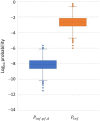Quantitative Risk Assessment of Wind-Supported Transmission of Highly Pathogenic Avian Influenza Virus to Dutch Poultry Farms via Fecal Particles from Infected Wild Birds in the Environment
- PMID: 39057798
- PMCID: PMC11279698
- DOI: 10.3390/pathogens13070571
Quantitative Risk Assessment of Wind-Supported Transmission of Highly Pathogenic Avian Influenza Virus to Dutch Poultry Farms via Fecal Particles from Infected Wild Birds in the Environment
Abstract
A quantitative microbial risk assessment model was developed to estimate the probability that the aerosolization of fecal droppings from wild birds in the vicinity of poultry farms would result in the infection of indoor-housed poultry with highly pathogenic avian influenza virus (HPAIv) in the Netherlands. Model input parameters were sourced from the scientific literature and experimental data. The availability of data was diverse across input parameters, and especially parameters on the aerosolization of fecal droppings, survival of HPAIv and dispersal of aerosols were uncertain. Model results indicated that the daily probability of infection of a single poultry farm is very low, with a median value of 7.5 × 10-9. Accounting for the total number of poultry farms and the length of the bird-flu season, the median overall probability of at least one HPAIv-infected poultry farm during the bird-flu season is 2.2 × 10-3 (approximately once every 455 years). This is an overall estimate, averaged over different farm types, virus strains and wild bird species, and results indicate that uncertainty is relatively high. Based on these model results, we conclude that it is unlikely that this introduction route plays an important role in the occurrence of HPAIv outbreaks in indoor-housed poultry.
Keywords: HPAI; QMRA; aerosolization; fecal droppings; wild birds; wind.
Conflict of interest statement
The authors declare no conflicts of interest.
Figures




Similar articles
-
Bridging the Local Persistence and Long-Range Dispersal of Highly Pathogenic Avian Influenza Virus (HPAIv): A Case Study of HPAIv-Infected Sedentary and Migratory Wildfowls Inhabiting Infected Premises.Viruses. 2022 Jan 10;14(1):116. doi: 10.3390/v14010116. Viruses. 2022. PMID: 35062320 Free PMC article.
-
Genetic relationship between poultry and wild bird viruses during the highly pathogenic avian influenza H5N6 epidemic in the Netherlands, 2017-2018.Transbound Emerg Dis. 2019 May;66(3):1370-1378. doi: 10.1111/tbed.13169. Epub 2019 Apr 5. Transbound Emerg Dis. 2019. PMID: 30874364 Free PMC article.
-
Detection of airborne wild waterbird-derived DNA demonstrates potential for transmission of avian influenza virus via air inlets into poultry houses, the Netherlands, 2021 to 2022.Euro Surveill. 2024 Oct;29(40):2400350. doi: 10.2807/1560-7917.ES.2024.29.40.2400350. Euro Surveill. 2024. PMID: 39364599 Free PMC article.
-
Review of the Highly Pathogenic Avian Influenza in Argentina in 2023: Chronicle of Its Emergence and Control in Poultry.Pathogens. 2024 Sep 19;13(9):810. doi: 10.3390/pathogens13090810. Pathogens. 2024. PMID: 39339001 Free PMC article. Review.
-
The genetics of highly pathogenic avian influenza viruses of subtype H5 in Germany, 2006-2020.Transbound Emerg Dis. 2021 May;68(3):1136-1150. doi: 10.1111/tbed.13843. Epub 2020 Sep 29. Transbound Emerg Dis. 2021. PMID: 32964686 Review.
Cited by
-
Investigation of human infection with H5N6 avian influenza cases in Sichuan Province from 2014 to 2024: a retrospective study.Front Public Health. 2025 Jun 6;13:1603158. doi: 10.3389/fpubh.2025.1603158. eCollection 2025. Front Public Health. 2025. PMID: 40547469 Free PMC article.
References
-
- WOAH (World Organisation for Animal Health) Manual of Diagnostic Tests and Vaccines for Terrestrial Animals. Chapter 3.3.4. Avian Influenza (Including Infection with High Pathogenicity Avian Influenza Viruses) 2023. [(accessed on 24 June 2024)]. Available online: https://www.woah.org/en/what-we-do/standards/codes-and-manuals/terrestri...
MeSH terms
Substances
Grants and funding
LinkOut - more resources
Full Text Sources
Medical

